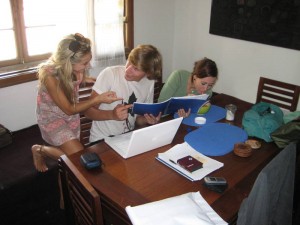
A shared apartment…
When you study Spanish abroad, your choice of living situation can greatly influence your experience. Unless you already have friends or relatives living in the area in which you are staying, you need to make housing arrangements before your departure. It is important to remember that your accommodation can influence your trip socially as well as culturally.
Typically with ECELA programs, students choose between a homestay and a shared apartments. (Click on the highlighted words to view our website’s information about our accommodations.) However, occasionally, students choose to stay in a private apartment rented on their own accord or even a hotel. Keep in mind that a hotel room will be far more expensive

…or a homestay?
that most other options. In fact, the cost of a week in a hotel is comparable to the money that you would spend for an entire month of residency in a shared apartment. While some people may consider a private apartment expensive, it is far less expensive than a hotel room. Yet, this choice of living situation also has drawbacks, such as the added consideration of a security deposit. Often it is challenging to make these arrangements before your arrival in the country.
A homestay arrangement is one in which you stay with a local host while you study Spanish abroad. Usually you will take a room in the home of a local host family. Traditionally, you will live with an older couple that has extra space due to the fact that their children have grown up and moved out of the house. A homestay situation is the perfect set-up to immerse yourself in the local culture and practice Spanish in your living environment. On the negative side, however, high school- and college-aged students may feel as though they are living with their parents when they opt for a homestay.
While a homestay may be pricier than some other options, keep in mind that you will receive breakfast and dinner each day. After you factor in the meals that you will be receiving, the price for a homestay is really very comparable to staying in a shared apartment. Receiving breakfast and dinner proves to be very convenient as you will most likely be eating lunch during the day with other students.
A shared apartment is a very popular living arrangement for those in Spanish immersion school. As the name indicates, this means you will share an apartment with other students. This arrangement has the benefit of being a very social environment. You will get to know other cultures too, as your flatmates will be from countries from around the world. For example, a shared apartment in Buenos Aires might have five students whose origins include Sweden, Australia, the USA, UK, and Germany.
However, just as there are with a homestay, there are a few negative factors associated with a shared apartment. For example, students tend to be messier than families. Common areas are typically cleaned once a week, however, it is up to the students to cooperate on the other days. Additionally you will be not immersed in Spanish as you would be in a homestay arrangement.
So what type of living situation is ultimately the best option? For an optimal experience, you may want to combine these options. For example, you could spend the first few weeks of your program in a homestay to get to know the language, culture, and the city, and afterward switch to living in a shared apartment. This plan will also give you the advantage of having free meals at home the first few weeks and then going out to eat more once you have made some friends. You also could cook for yourself after observing your host family and how they use the local produce.
If you combine different living options while you attend Spanish immersion school, you will reap the benefits that accompany each one. You will be able to first have the immersive cultural experience of living with a family, and then transition to having more privacy and socialization time with your peers. If you have a sufficient amount of time, it only makes sense to take advantage of both of these programs.